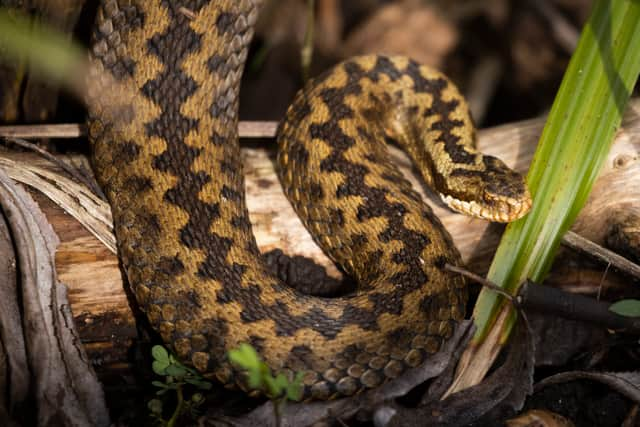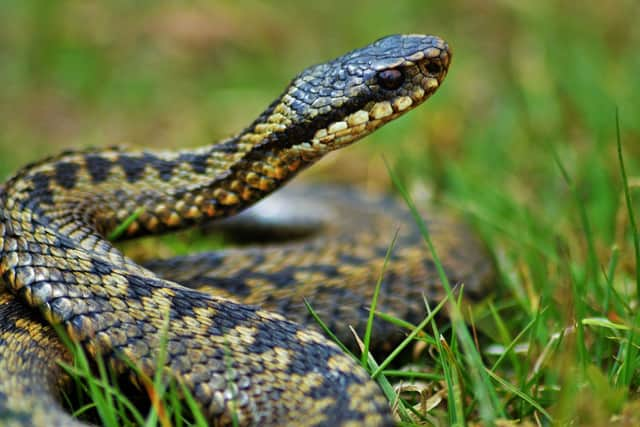Are adders poisonous? Surge of venomous snakes spotted on UK beaches - can they harm humans?
and live on Freeview channel 276
Tourists enjoying or planning trips to the beach has been warned about the surge of venomous adders on Britain’s beaches.
According to reports, the snakes are settling in sand dunes near popular tourist locations, such as The Rest Bay area of Porthcawl in Wales.
Advertisement
Hide AdAdvertisement
Hide AdAdders are the UK’s only venomous snake, and usually are not aggressive, but will bite if they feel threatened. However, their venom can be painful and cause band inflammation and it can be very dangerous to the very young, sick or old.
New research published in the Clinical Toxicology journal revealed more people in the UK are suffering from snakebites than ever before.
So where have adders been spotted in the UK? Here’s what you need to know.
Where have adders been spotted in the UK?


In Wales, Bridgend council has seen an increase in the number of deadly snakes in the Rest Bay Area of Porthcawl.
Advertisement
Hide AdAdvertisement
Hide AdWales Online reports that cabinet member for communities, councillor John Spanswick said: “The UK is home to both grass snakes and adders, and while only the adder is toxic, its bite is rarely fatal and can be easily treated.
“Most reported incidents involve dogs rather than humans, and in the vast majority of cases, a full recovery is made.
“The council and its partners have produced a handy guide called ‘Snakes of the Bridgend Coast’ to help people spot snakes and other reptiles within Bridgend County Borough, and which offers advice on what to do if you come across one.
“The best advice for anyone who encounters a snake while out and about is to simply leave them alone, and try not to disturb them.
Advertisement
Hide AdAdvertisement
Hide Ad“All British reptiles are protected under law, and the adder is a species that is considered to be particularly at risk.”
However, adders have also been spotted on Hemsby beach in Norfolk, when in April the parents of Jake Closier, 8, had to rush him to hospital after being bitten causing his hand to swell up “five times the normal size”.
His mother, Sophie, 32, from Camden said: “We were talking a family walk along the beach to look for the seals and were heading towards Winterton.
“My son was running around on the beach in the sand dunes and he fell over and was bit by the venomous snake.
Advertisement
Hide AdAdvertisement
Hide Ad“Within about 30 seconds, I checked his finger and it went completely hard and I could see a puncture wound.
“We had to be at the hospital within half-an-hour, by this time his hand had swelled to about five times the size of a normal hand.
“His hand was so swelled and hard, we thought it was going to burst. The puncture wound was black. He was vomiting and sweating.
“The venom had shrunk his veins so they couldn’t get the anti-venom into him properly. They somehow managed to get it in him within the hour.
Advertisement
Hide AdAdvertisement
Hide Ad“He was on the anti-venom for an hour and then had to have a flush and was on hourly observations for his heart rate, breathing and circulation.”
After being observed for 24 hours, Jake was allowed to return home.
Where do adders live?
According to The Wildlife Trusts, the adder is a small snake that prefers woodland, heathland and moorland habitats and can be found across the country except for the Isles of Scilly, the Channel Islands, Northern Ireland and the Isle of Man.


They are seen between March and October, hibernating for the other five months, and can be identified as a greyish snake, with a dark and very distinct zig-zag pattern down their back, and a red eye. Males tend to be more silvery-grey in colour, while females are lighter or reddish-brown.
What to do if bitten by an adder
Advertisement
Hide AdAdvertisement
Hide AdThe NHS website says to call 999 or go to A&E immediately if you think you have been bitten by a snake.
Whilst waiting for help you should:
- stay calm, most snake bites in the UK are not serious and can be treated
- keep the part of your body that was bitten as still as you can
- lie in the recovery position if you can
- take paracetamol for any pain
- try to remember the colour and pattern of the snake to tell the doctor
- take off any jewellery and loosen clothes near the bite, in case it swells
The NHS website says not to:
- go near the snake, or try to catch or kill it
- do not try to suck or cut the poison (venom) out of the bite
- do not tie anything tightly around the part of the body where the bite is
- do not take aspirin or ibuprofen, as they can make bleeding worse
After being bitten by a snake you will need to stay in hospital for 24 hours and may be given a tetanus injection. If the snake was venomous you will be treated with medicine to fight the venom.
What is the difference between poisonous and venomous?
According to biologists, the term venomous is for organisms that bite or sting to inject their toxins, but poisonous is the term for organisms that unload toxins when you eat them.
Comment Guidelines
National World encourages reader discussion on our stories. User feedback, insights and back-and-forth exchanges add a rich layer of context to reporting. Please review our Community Guidelines before commenting.
